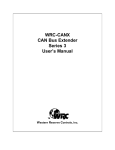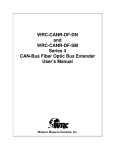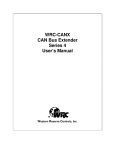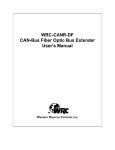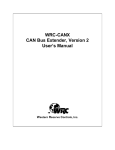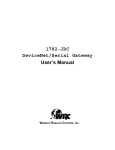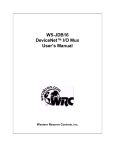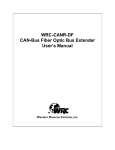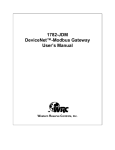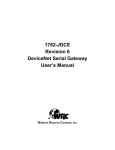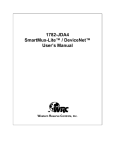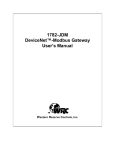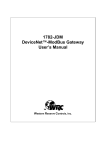Download Western Reserve Controls WRC-CANR-DF User`s manual
Transcript
WRC-CANR-DF-DN Series 3 CAN-Bus Fiber Optic Bus Extender User’s Manual W estern Reserve Controls, Inc. Western Reserve Controls PUB 14.1 WRC-CANR-DF-DN User’s Manual Series 3 Although every effort has been made to insure the accuracy of this document, all information is subject to change without notice. WRC takes no liability for any errors in this document or for direct, indirect, incidental or consequential damage resulting from the use of this manual. Document PUB 14.1 Rev 3.00 March 2003 Copyright © 1998-2003 WRC Western Reserve Controls, Inc. 1485 Exeter Road Akron OH 44306 330-733-6662 (Phone) 330-733-6663 (FAX) [email protected] (Email) http://www.wrcakron.com (Web) SmartMux-Lite, CAN-Bus Extender and WRC are trademarks of Western Reserve Controls, Inc. DeviceNet is a trademark of the Open DeviceNet Vendor Association, Inc. (“ODVA”). SDS is a trademark of the Honeywell, Inc. All other trademarks are property of their respective companies. Western Reserve Controls PUB 14.1 WRC-CANR-DF-DN User’s Manual Series 3 TABLE OF CONTENTS 1. 1.1. 1.2. 1.3. 1.4. OVERVIEW ............................................................................................................................................................................ 1 SERIES 3 SPECIFIC FEATURES ..........................................................................................................................................1 FEATURES............................................................................................................................................................................2 BASIC OPERATION .............................................................................................................................................................2 REFERENCE DOCUMENTS.................................................................................................................................................3 2. QUICK START....................................................................................................................................................................... 4 3. GENERAL SPECIFICATIONS ............................................................................................................................................ 5 4. HARDWARE INSTALLATION AND CONFIGURATION............................................................................................ 6 4.1. OVERVIEW ...........................................................................................................................................................................6 4.2. LED OPERATION ................................................................................................................................................................6 4.3. DIP SWITCH SETTINGS .....................................................................................................................................................8 4.4. POWER REQUIREMENTS....................................................................................................................................................9 4.5. CAN NETWORK CABLING AND CONFIGURATION........................................................................................................9 4.5.1. Cable Lengths.......................................................................................................................................................... 9 4.5.2. Network Termination ............................................................................................................................................. 9 4.5.3. CAN-Bus Connection Wiring..............................................................................................................................10 4.5.4. Alternate Connector Options..............................................................................................................................12 4.6. FIBER CABLE .....................................................................................................................................................................12 5. 5.1. OPERATION ........................................................................................................................................................................13 A PPLICATION NOTES......................................................................................................................................................13 6. ACCESSORIES AND OTHER WRC PRODUCTS .......................................................................................................15 7. TROUBLESHOOTING.......................................................................................................................................................17 8. SUMMARY OF CHANGES TO SERIES 3 FROM REV 2 ............................................................................................19 8.1. 8.2. 8.3. 8.4. 8.5. 8.6. 8.7. DIP SWITCH BAUD RATE SETTINGS ............................................................................................................................19 INDICATOR LED’S.............................................................................................................................................................19 TERMINATING RESISTORS...............................................................................................................................................19 OPERATION AND FUNCTIONALITY..............................................................................................................................19 2.2KM FIBER LINK AND DIAGNOSTICS..........................................................................................................................19 ENHANCED CAN SUPPORT ............................................................................................................................................20 FIELD PROGRAMMABLE UPDATES................................................................................................................................20 i Western Reserve Controls PUB 14.1 WRC-CANR-DF-DN User’s Manual Series 3 LIST OF TABLES TABLE 4-1 M ODULE STATUS LED (LABELED MS)....................................................................................................................7 TABLE 4-2 LOCAL DEVICE ’S NETWORK STATUS LEDS (LABELED NSA)..............................................................................7 TABLE 4-3 REMOTE DEVICE ’S NETWORK STATUS LEDS (LABEL NSB) .................................................................................7 TABLE 4-4 DIAGNOSTIC STATUS LEDS (LABELED DNG)..........................................................................................................8 TABLE 4-5 BAUD RATE SETTINGS FOR SWITCHES.....................................................................................................................8 TABLE 4-6 NETWORK M AXIMUM LENGTHS - DEVICE NET ......................................................................................................9 TABLE 4-7 NETWORK M AXIMUM LENGTHS - SDS....................................................................................................................9 TABLE 4-8 TERMINATING RESISTORS..........................................................................................................................................10 TABLE 4-9 DEVICENET CABLE SPECIFICATIONS........................................................................................................................11 TABLE 4-10 SDS CABLE SPECIFICATIONS...................................................................................................................................12 TABLE 6-1 A CCESSORIES AND OTHER WRC PRODUCTS..........................................................................................................16 LIST OF FIGURES FIGURE 1-1 TYPICAL FIBER OPTIC BUS EXTENSION APPLICATION .........................................................................................3 FIGURE 4-1 WRC-CANR-DF-DN CAN-BUS EXTENDER...........................................................................................................6 FIGURE 4-2DEVICENET NETWORK SIDE A CABLE CONNECTOR – M ALE (PINS).................................................................11 FIGURE 4-3 SDS M INI CONNECTOR ...........................................................................................................................................11 FIGURE 5-1 CANR-DF ON A DROP LINE .....................................................................................................................................14 FIGURE 5-2 CANR-DF ON MULTIPLE DROP LINES...................................................................................................................14 ii Westrn Reserve Controls PUB 14.1 1. WRC-CANR-DF-DN User’s Manual Overview The WRC-CANR-DF Fiber Optic CAN Bus Extender converts a copper cable medium CAN-Bus network to a fiber optic medium. The WRC-CANR-DF-DN is always used in pairs and, along with the fiber optic cable set, inserts a length of fiber media into the copper CAN Bus network. The primary purposes of this type of configuration is to extend the maximum length defined for one continuous network cable bus up to 2.2km and to provide network protection from external, high-energy electrical interference, such as lightning storms, arc welders, etc. They can be connected in a bus trunk line or drop line. A WRC-CANR can be used for quite a number of helpful purposes, including • To provide an electrically-isolated fiber transmission segment to your CAN bus for more secure network in high-energy environmental conditions • to extend the network beyond its absolute maximum length (e.g., up to 2200 meters additional length) at the slowest speed • to implement a longer network for a given baud rate (e.g., pushing a 500K baud network beyond 100 m for DeviceNet) • to provide higher speed baud rates for a given network length • to extend the length of the drop cable (e.g., longer drops than 6 m for DeviceNet) • to provide 2600V electrical isolation between the 2 sub-nets • to create a unique network topology instead of a conventional bus structure, such as a star configuration The Extenders are transparent to the other nodes on the bus. They receive and actively re-transmit (store-and-forward) each message received at either side of the network without interpreting the message or acting upon it. The Fiber Extenders perform all appropriate CAN Bus arbitration on the copper bus as it retransmits the message. The WRC-CANR-DF-DN is a member of WRC’s family of products that extend the system communications lengths for DeviceNet, CANopen, SDS (Smart Distributed System) and other CAN, V2.0, Part A or Part B, serial bus systems. By allowing the user to extend the bus length for any given speed, they assist the user in cost-effectively implementing I/O or other nodes on these buses at remote locations that would be more difficult or more expensive to do otherwise. The unit derives its power through the copper network connector on Side A. 1.1. Series 3 Specific Features The Series 3 CANR provides enhancements over previous versions. Enhancements include: • Up to 2.2 km fiber lengths • CAN 2A and 2B, and remote frame, support • Up to 1M Baud CAN bus operation available • Enhanced Autobaud operation • Either unit in a pair can Autobaud from the other units defined baud rate 1 Western Reserve Controls PUB 14.1 WRC-CANR-DF-DN User’s Manual Series 3 • Jumper-selectable terminating resistor on-board the CANX • Increased message internal buffers – Automatic Memory Technology (AMT) operation • Eliminates the distinction between WRC’s earlier version Type 1 and Type 2 CANR’s 1.2. Features The WRC-CANR-DF-DN has the following features: • Extends CAN-Bus cable lengths - trunk line or drop lines • Expands the usable applications for CAN-Bus systems • Allows operation at higher speeds for specific distances • Provides superior electrical interference protection to copper cables • Operates at 125K, 250K, 500K and 1M baud • Switch-selectable Autobaud or fixed baud rate operation • Automatic speed selection - no configuration required • Isolates the two sections of the copper bus • Transparent to the Master and Slave devices on the bus • No address selection needed • No configuration parameters • DeviceNet; SDS; CAN, V2.0, Part A and Part B compatible • Powered from the 24Vdc supplied by bus network or the user • Sealed NEMA-4X enclosure • Standard round, mini-style connector with male pins for copper cable • Standard Fiber Optic ST female connector, 62.5/125um technology • Standard CAN chips manage bus error detection • Standard CAN chips handle message bus contention • Less than 100 µsec latency • Jumper-selectable termination built in on cable side • 4 bi-color (red/green) status LEDs • 2 green fiber transmit and receive LEDs 1.3. Basic Operation Two CANR-DF units are required for each application – both units are identical. It does not matter which is placed in which position with respect to the network topology or other devices on the network. There are two bus connections for each CANR-DF, referred to as the Copper Cable Network Side (Side A) and Fiber Cable Network Side (Side B). The CAN Bus copper cable is connected to side A of the CANR-DF receives its power from side A. Figure 1-1 shows a typical application. Whenever a message is transmitted on the Bus to which CANR-DF is connected, CANR-DF receives the message on the side where it was initiated and performs a store-and-forward of the message to the other side. This action is performed in each direction and is performed for any valid CAN message independent of who generated it or to whom it is intended. There is approximately a 75µsec propagation delay of the message through the CANR-DF. The CANR-DF is not addressed as a specific device on the Bus and cannot be interrogated by other nodes. It is transparent to all other nodes on the bus. 2 Western Reserve Controls PUB 14.1 WRC-CANR-DF-DN User’s Manual Series 3 Fiber-optic extenders especially useful for outdoor applications Host PLC Up to 2.2 km Extender Extender Figure 1-1 Typical fiber optic bus extension application 1.4. Reference Documents The following documents are referenced in this User’s Manual • ODVA DeviceNet Specification Volume I, Release 2.0 • Honeywell Micro Switch Specification GS 052 104, “SDS Smart Distributed System Physical Layer Specification”, release date 12/8/1994 3 Western Reserve Controls PUB 14.1 2. WRC-CANR-DF-DN User’s Manual Series 3 Quick Start To quickly and easily install your CAN-Bus Fiber Optic Extenders in your DeviceNet system, follow the instructions below. For more details, see Section 4. 1. These units are used in pairs. You need two (2) CANR-DF units and two (2) 62.5/125, multi-mode fiber cable lengths, terminated with ST male connectors. 2. Set the baudrate of each CANR-DF to Autobaud by setting the switches on the 8-position switch block SW1 to all OPEN. 3. Using on-board jumper W1, terminate CAN-Bus network, as appropriate. (This is especially critical at the higher baud rates.) • For trunk lines, install W1. • For drop lines, remove W1. 4. Connect the fiber cables to the CANR of one unit. Make sure they are clearly marked on both ends to differentiate between the two lines. 5. Make sure that there is power on the CAN-Bus Network and plug the Network cable with a 5-pin round female MINI connector into the CAN-Bus Extender. 6. The CANR-DF Extender will undergo its initialization sequence, flashing the LEDs. After approximately 5 seconds, the Module Status LED (labeled “MS”) will go on solid green and network LEDs (labeled “NSA” and “NSB”) will flash green. 7. Repeat steps 2-6 above for the second CANR-DF. Note: Be sure to connect the fiber from the TX port on one device to the RX port on the other. 8. Connect the desired network devices to both sides of the copper CAN bus. 9. Both Network A and B Status LEDs (NSA and NSB) will go on solid on each unit once a valid CAN message is received into either side of the Extender and the baudrate auto-detect has been successfully performed. 10. You may observe the small green LEDs marked RXF and TXF, next to the fiber ports, illuminate when data is received or transmitted. 11. The CAN-Bus Extenders are now operating on the network and they are ready operate in the CAN network. 12. If any of the LED’s – marked DGN, NSA and NSB – blink red, this indicates that the internal message buffer on the CANR-DF has been filled before the device could transfer all previously received messages out the other side. Some messages may be lost. Slowing down the scan rate should help eliminate this. 4 Western Reserve Controls PUB 14.1 3. WRC-CANR-DF-DN User’s Manual Series 3 General Specifications Product: WRC-CANR-DF-DN, Series 3 CAN-Bus Extender and Fiber Optic Converter Description: Electrical Extender to extend the cable distances of CAN-based protocol products and convert the copper network to a fiber optic link. Device Type: Communications Extender Product Revision: 3.?? DeviceNet Conformance: Designed to conform to the ODVA DeviceNet Specification Volume I, Version 2.0 and Volume II, Version 2.0. Baud rate: 125K, 250K, 500K and 1M baud fixed or auto-detect baud rate Address selection: Not applicable Bus Connection: Used On Device: CAN-Bus Cable: Fiber Optic Cable: 62.5/125nm, multi-mode, ST termination Fiber Cable Length: 2200 meters (max) Fiber Connection: Used On Device: Fiber Cable: Status Indicators: MS - Module Status: NSA - Copper Network A Status: NSB - Fiber Network B Status: DGN - Diagnostic Data: TXF - Fiber Transmit Active: RXF - Fiber Receive Active: Voltage Isolation: Provided by fiber cable system Maximum power: Voltage: Current: Power: Mounting: Panel-mount, 4 screws Size: Length: Depth: Height: Operating Temp: 0-70 ºC Humidity: 0-95% RH, non-condensing Woodhead # 1R5006A17A120, male pins, male threads See accessories list ST female ST male green/red bi-color green/red bi-color green/red bi-color green/red bi-color green LED green LED 11 - 25 Vdc 160 mA @ 11 Vdc - 70 mA @ 25 Vdc 1.8 W 5.11” (130 mm) 2.27” (57,7 mm) 3.70” (94,0 mm) 5 LED LED LED LED Western Reserve Controls PUB 14.1 4. WRC-CANR-DF-DN User’s Manual Series 3 Hardware Installation and Configuration 4.1. Overview A CAN-Bus Extender is a single device connected to two parts of a single CAN-Bus network. The CANR-DF is a NEMA-4X enclosure and is panel mounted. NSA DeviceNet Male, Mini DGN MS W1 NETWORK A 2.27” ( 57,7 mm) DeviceNet Female, Mini --NET A- --NET B-1 2 3 4 5 6 7 8 SW1 OPEN W2 NSB NETWORK B 5.11” (130 mm) Figure 4-1 WRC-CANR-DF-DN CAN-Bus Extender 4.2. LED Operation A WRC-CANR-DF-DN Multiplexer has six (6) LEDs that provide visual status information to the user about the product and the DeviceNet network. The LED’s definitions are summarized as follows and more thoroughly in the tables below in Table 4-1, Table 4-2 and Table 4-4. • • • • • • MS – Module Status – indicates the general health of the unit and its ability to Store-and-Forward messages. NSA – Network Status A – indicates the condition of the CAN bus connection of this Local unit. NSB – Network Status B – indicates the condition of the Remote unit’s CAN bus operation on the other end of the fiber cable. DGN – Diagnostic – indicates status of the fiber-optic link. RXF – Receive Fiber – green indicates electrical signals being received by the CANR. TXF – Receive Fiber – green indicates electrical signals being sent by the CANR. 6 Western Reserve Controls PUB 14.1 WRC-CANR-DF-DN User’s Manual Series 3 Table 4-1 Module Status LED (labeled MS) LED State Module Status Meaning OFF No Power There is no power through DeviceNet. Green Device Operational WRC-CANX is operating normally. Flashing Red Minor Fault Advanced Memory Technology (AMT) buffers space exceeded. Red Unrecoverable Fault WRC-CANX may be damaged. Flashing Red/Green Device Self-Testing WRC-CANX is in self-test mode. Table 4-2 Local Device’s Network Status LEDs (labeled NSA) LED State Module Status Meaning OFF No Power / Not on-line Flashing Green Idle Fast Flashing Green Autobaud selection Green On-line Flashing Red CAN controller buffer overflow Red Critical link failure (Bus Off) WRC-CANX has no power or device is not operating. WRC-CANX has not received a valid message for 0.5 sec. The WRC-CANX is waiting for a valid message to fix the baudrate. WRC-CANX is operating normally and receiving messages. There is more traffic on the network than the system can handle. WRC-CANX has detected an error that makes it incapable of communicating on the link. Table 4-3 Remote Device’s Network Status LEDs (label NSB) LED State Module Status Meaning OFF No Power / Not on-line Flashing Green Idle Fast Flashing Green Autobaud selection Green On-line Flashing Red CAN controller buffer overflow Red Critical CAN link failure (Bus Off) 7 WRC-CANX has no power or device is not operating. WRC-CANX has not received a valid message for 0.5 sec. The WRC-CANX is waiting for a valid message to fix the baudrate. WRC-CANX is operating normally and receiving messages. There is more traffic on the network than the system can handle. WRC-CANX has detected an error that makes it incapable of communicating on the CAN bus. Western Reserve Controls PUB 14.1 WRC-CANR-DF-DN User’s Manual Series 3 Table 4-4 Diagnostic Status LEDs (labeled DNG) LED State Module Status Meaning OFF Normal Normal operation. Green Fiber Link OK Serial link to fiber network operating. Red Time-out Flashing Red Communications error Unit has not received a serial message from the fiber link. Internal FIFO stack has overflowed on the fiber link interface. The Green TXF and RXF LED’s are illuminated when data is actively transmitted out to the fiber link. 4.3. DIP Switch Settings The WRC-CANR-DF has an 8-pole DIP switch. • • Switch positions 1-4 are used to set the baud rate of the CANR on which it is located (the local unit). Switch positions 5-8 are used to set the baud rate on the CANR at the other end of the fiber cable (the Remote Device). The baud rates can be set independently, or one side can take its baud rate from the other side (in the “Remote” setting). Table 4-5 Baud Rate Settings for Switches Local Baud rate Remote Position 1 Position 5 Position 2 Position 3 Position 4 Position 6 Position 7 Position 8 Meaning 125K CLOSED CLOSED CLOSED CLOSED Fixed 250K CLOSED CLOSED CLOSED OPEN Fixed 500K CLOSED CLOSED OPEN CLOSED Fixed Autobaud CLOSED CLOSED OPEN OPEN Autobaud OPEN Takes baud rate from the opposite end device. If both sides are remote, Autobaud from either side. Remote N/A OPEN OPEN OPEN ALL OTHER POSITIONS 8 Reserved for future use Western Reserve Controls PUB 14.1 WRC-CANR-DF-DN User’s Manual Series 3 4.4. Power Requirements The WRC-CANR-DF-DN CAN-Bus Extender subsystem is powered from the 11-25 Vdc provided by the DeviceNet network. The WRC-CANR-DF-DN consumes 70 mA of current at 24 Vdc, or 1.8 Watts, typical. See Section 3. 4.5. CAN Network Cabling and Configuration This section provides general guidelines for connecting DeviceNet and SDS systems. You can find detailed specifications in the referenced ODVA DeviceNet and Honeywell SDS specifications. 4.5.1. Cable Lengths The following provide cable length limits for DeviceNet and SDS systems. These numbers apply independently to each physical section of the network, whether it is copper or fiber. Table 4-6 Network Maximum Lengths - DeviceNet Baud Rate 125 Kbits/s 250 Kbits/s 500 Kbits/s Trunk Line Length Maximum Distance Meters Feet 500 m 1640 ft 250 m 820 ft 100 m 328 ft Drop Length Maximum Cumulative Meters Feet Meters Feet 6m 20 ft 156 m 512 ft. 6m 20 ft 78 m 256 ft. 6m 20 ft 39 m 128 ft. DeviceNet has a limit of 64 nodes per network for any baud rate. The CANR-DF is transparent to the network and does not count as an addressed device. However, Table 4-7 Network Maximum Lengths - SDS Baud Rate 125 Kbits/s 250 Kbits/s 500 Kbits/s 1 Mbits/s Trunk Line Length (maximum) Meters Feet 457.2 1500 182.8 600 91.4 300 22.8 75 Drop Length (maximum) Meters Feet 3.6 12 1.8 6 0.9 3 0.3 1 No. of Nodes 64 64 64 32 SDS has a limit of 32 nodes per network for any baud rate. The CANR-DF does not count as an addressed device. 4.5.2. Network Termination 9 Western Reserve Controls PUB 14.1 WRC-CANR-DF-DN User’s Manual Series 3 A CAN-Bus system must be terminated at each end of a copper trunk line. The host controller and the last node device or WRC CAN-Bus Extender on the network must always be terminated to match impedance and eliminate reflections, even if only two nodes are present. Follow the information below when using a CANR-DF. The CANR Series 3 has a built-in terminator which can selectively included or omitted from the network. To include the on-board terminator (on the DeviceNet side), install jumper W1; or remove the W1 jumper if the on-board terminator in not desired. The CANR is shipped from the factory with the jumper installed. See Figure 4-1 for the location of the jumper. Trunk line use: For the purpose of network termination, the CANR-DF is treated as the last node on the copper section of the trunk network (side A) to which it is connected. Therefore, when a CANR-DF is used directly in a trunk line, it must be terminated on side A. The terminating resistor built into the CANR-DF at W1 must be installed, or another terminator at the end of the line could be used in the place of the W1 terminator. Drop line use: When CANR-DF is used in a drop line line (the Network A side is toward the main trunk), the Network A connection must not be terminated. The user must remove the built-in terminator by removing the jumper plug at W1. Some specifications for the terminating resistor are: Table 4-8 Terminating Resistors DeviceNet 121 ohm 1% metal film 1/4 watt SDS 120 ohm 2% 1/4 watt Important: Per the DeviceNet and SDS specs -- do not terminate devices on drop lines. 4.5.3. CAN-Bus Connection Wiring The CANR-DF uses the round, mini-style connector on the copper side A and standard ST connectors on the fiber side B. 10 Western Reserve Controls PUB 14.1 WRC-CANR-DF-DN User’s Manual Series 3 3 4 2 5 1 Figure 4-2DeviceNet Network Side A cable connector – Male (pins) Pin # 1 2 3 4 5 Function Drain V+ VCAN_H CAN_L Wire color bare red black white blue Table 4-9 DeviceNet cable specifications Figure 4-3 SDS Mini Connector 11 Western Reserve Controls PUB 14.1 WRC-CANR-DF-DN User’s Manual Series 3 Pin # 1 2 3 4 5 Function Drain V+ GND CAN_H CAN_L Wire color Bare Brown Blue Black White Table 4-10 SDS cable specifications 4.5.4. Alternate Connector Options Cable sets may be purchased from an appropriate vendor or custom-made. Turck supplies individual connectors that may be used to build custom DeviceNet or SDS copper cables. Turck part number B 41510/16 is a 5-pin, 600V, 9A connector that mates with a number of cables that may be used for the Network A side on the CANR. Contact WRC or your local Turck dealer. 4.6. Fiber Cable The CANR employs fiber optic driver and receiver that is capable of operating 62.5/125 multi-mode cable a distance of 2200 meters. They use ST connectors. The fiber cables are connected between TX of one CANR and RX of the other. For custom applications using different fiber cable technology, contact WRC. 12 Western Reserve Controls PUB 14.1 5. WRC-CANR-DF-DN User’s Manual Series 3 Operation Each CANR system receives CAN messages and then packs and transmits the messages over the fiber link to the other CANR, which produces the messages onto its CAN bus network. The CANR pair provides electrical isolation between the two CAN sub-networks. It has no CAN address and is logically transparent to the CAN network protocol. The CANR does not interpret nor act on the CAN messages. The CAN Bus is connected to the A Side of the CANR-DF and receives its power from the Bus. Whenever a message is transmitted on the Bus to which the CANR-DF pair is connected, one CANR-DF receives the message on the side where it was initiated and performs a store-and-forward of the message to the other side. This action is performed for any valid CAN message independent of who generated it or to whom it is intended. There a propagation delay of the message through the CANR-DF system, consisting of 2 parts: each CANR introduces approximately a 75 µsec delay, and the transmission time on the fiber link (in both directions) introduces additional delay. The CANR Series 3 adds the capability for each unit to monitor and report on the status of the other unit in the pair. The NSB LED on one unit reflects the status of the other unit. In this manner you can determine the operating status of both units by observing just one of them. Also the CANR allows you set up the baud rate for both units from just one. See the section on switch settings, 4.3 above, for more details. 5.1. Application Notes NOTE: CANR-DF’S ARE ALWAYS USED IN PAIRS! To help insure ease of installation and reliable operation of your system, the following guidelines should be followed CANR-DF installation in your CAN network. 1. Proper CAN bus termination is critical to reliable operation of the network. Set the SW1 jumpers on the CANR’s appropriately. 2. Other than improper terminators, the most common problem is correct fiber cable connection and termination. Make sure one cable connects TX on one to RX on the other and vice versa. Also confirm that the fiber itself is good quality and the ends are correctly polished and terminated with ST connectors. 3. Use the on-board LEDs to help determine the health of the fiber cable interconnection. 4. In Autobaud applications, the baud rate that each device selects will be defined by the first valid message received from either the CAN-Bus or via the fiber connection from the other device. 5. Although multiple CANR’s can used in series, Use only one CANR-DF pair in any network section. That is, only use one CANR-DF pair per trunk line or drop line. 6. CANR-DF is not a grounded device and the Bus shield is not connected electrically to the device. Therefore, follow appropriate wiring practices to eliminate noise and other problems. Example of a valid drop line applications are shown in the following figures. See Figure 1-1 for an example trunk line application. 13 Western Reserve Controls PUB 14.1 WRC-CANR-DF-DN User’s Manual Series 3 Linear Bus Topology - extended fiber drop Terminator Tap Terminator Drop Line Fiber Extender Nodes 2.2km Fiber Fiber Extender Zero Drop Short Drops Figure 5-1 CANR-DF on a drop line Linear Bus Topology - multiple fiber drops Terminator Taps Drop Line Terminator Fiber Extender Fiber Extender Nodes 2.2km Fiber Fiber Extender Zero Drop Fiber Extender Short Drops Figure 5-2 CANR-DF on multiple drop lines 14 Western Reserve Controls PUB 14.1 6. WRC-CANR-DF-DN User’s Manual Series 3 Accessories and Other WRC Products The following components can be used with a JDxx for replacements or spare parts, or as complementary devices as a part of your DeviceNet system. • Part WRC P/N Equivalent Mfr. Part Number CANX-NEM Cable n/a Various manufacturers’ Mini-Style Connector Examples: Cable assy. w/ male threads, male pins: Turck RSM 570-*M/630 (“trunk line”) Turck RSM 571-*M/630 (“drop line”) • DIN rail (1 meter) WRC 50022 Phoenix Contact NS 35/7,5 0801733 (2 m) Allen-Bradley 199-DR1 (1 m) • Terminating resistor RM121DN 121Ω,1%, metal film, axial lead resistor 15 Western Reserve Controls PUB 14.1 WRC-CANR-DF-DN User’s Manual Series 3 Table 6-1 Accessories and Other WRC Products Part WRC Part Number DIN rail WRC 50022 Terminating resistor, axial lead RM121DN Connector, 5-pin mini-round for CANX, CANR B 4151-0/16 (Turck) Discrete I/O block – 4 channels 1782-JDB4 Discrete I/O block – 8 channels 1781-JDB8 Analog Input block – 4 channels, 10-bit 1782-JDA4 Analog I/O block – 8 channels, 12-bit 1782-JDA8 DeviceNet to Serial I/O Gateway 1782-JDC DeviceNet to Serial I/O Gateway, Enhanced 1782-JDCE DeviceNet-to-Serial I/O Gateway, 4 channels W5-JDC4 DeviceNet to Modbus Gateway 1782-JDM Discrete I/O block – 24 channels WRC1-JDB24 Discrete I/O block – 48 channels WRC1-JDB48 Discrete I/O, Analog Input block – 24 DIO, 32 AI WRC1-JDA/24 Discrete I/O, Analog Input block – 48 DIO, 32 AI WRC1-JDA/48 Analog I/O block - 32 channels WRC1-JDAIO Discrete and Analog I/O block – 24 DIO, 32 AIO WRC1-JDAIO/24 Discrete and Analog I/O block – 48IO, 32 AIO WRC1-JDAIO/48 Discrete I/O block – 8 DIs, 8 DOs, 4 AIs W5-JDB16x DeviceNet, CANopen Extender, DIN mount WRC-CANX-DIN-DN SDS Extender, DIN mount WRC-CANX-DIN-SD DeviceNet, CANopen Extender, DIN mount WRC-CANX-DIN-C7 DeviceNet, CANopen Extender, NEMA box WRC-CANX-NEM-AU DeviceNet, CANopen Extender, NEMA box WRC-CANX-NEM-DN SDS Extender, NEMA box WRC-CANX-NEM-SD DeviceNet, CANopen Extender, Fiber Optic, NEMA box WRC-CANR-DF-DN 16 Western Reserve Controls PUB 14.1 7. WRC-CANR-DF-DN User’s Manual Series 3 Troubleshooting This section identifies some of the common problem observed when commissioning or operating a CANR-DF Extender. Problem: DeviceNet devices will not communicate on the network Module Status LED is solid Green Network Status LEDs are flashing Green at ½ second intervals Meaning No Possible Solutions: 1. 2. 3. 4. transmissions have been received by the CANX for 0.5 seconds. Network cables are broken or disconnected. Network is not properly terminated. All devices have stopped trying to communicate on the network. Power has been lost on the B Side subnetwork. Problem: DeviceNet devices will not communicate on the network Module Status LED is solid Green Network Status LEDs are flashing Green quickly Meaning The CANX is in autobaud and is waiting for a valid message to fix its baud rate. Possible Solutions: 1. Network cables are broken or disconnected. 2. Network is not properly terminated. 3. All devices have stopped trying to communicate on the network. Problem: Some messages are missed on network. Module Status LED is solid Green NSA and NSB LEDs are flashing Red Meaning Internal CAN buffers are full. Network has more traffic than it can handle. Possible Solutions: 1. Reduce the scan rate from the Master. 2. Reduce the COS frequency on I/O devices. 3. Decrease the assembly sizes of I/O connections. 4. Recalculate the network traffic and bandwidth without the CANX. Problem: Some messages are missed on network. Module Status LED is flashing Red Meaning Internal AMT buffers are full. Network has more traffic than it can handle. Possible Solutions: 1. Reduce the scan rate from the Master. 2. Reduce the COS frequency on I/O devices. 3. Decrease the assembly sizes of I/O connections. 4. Recalculate the network traffic and bandwidth without the CANX. 17 Western Reserve Controls PUB 14.1 WRC-CANR-DF-DN User’s Manual Series 3 Problem: Device will not communicate on the network Module Status LED is solid Green Network Status LED is flashing Green Possible Solutions: 1. CANR does not see CAN messages on the network. 2. Network does not have a terminating resistor. Add a 121 ohm resistor across the CAN_H and CAN_L signals at the first and last nodes. 3. Network cable is broken or disconnected. 4. Network cable is miswired. Problem: Device will not communicate on the network DGN is solid red or off Possible Solutions: 1. Fiber Link is broken or not connected 2. Reterminate, Replace or Reconnect the optical fiber. 18 Western Reserve Controls PUB 14.1 8. WRC-CANR-DF-DN User’s Manual Series 3 Summary of Changes to Series 3 from Rev 2 To facilitate implementation of the new Series 3 CANR products for customers that are currently users of the CANR Revision 2.xx products, this section summarizes the product changes from Rev 2 to Series 3. 8.1. DIP Switch Baud Rate Settings Several new options exist for setting the baud rate on the CANR Series 3. • The Series 3 has an 8-position DIP switch block. All 8 switches are defined and used. • Both sides’ baud rates can be set up independently. • A “remote mode” exists which allows either side to set its baud rate based on the other side’s BR – in either fixed baud or autobaud. • See Section 4.3 for details. 8.2. Indicator LED’s The definition of some states of the LEDs have changed. Refer to Section 4.2 for details. 8.3. Terminating Resistors The Series 3 has an on-board terminating resistor on the CAN connection that can be selectively included or excluded from the network circuit. With jumpers W1, the CANR puts a 121-ohm resistor across the CAN_H and CAN_L lines on sub-network side A. See Section 4.5.2 and Table 4-8 for the location of this jumper. 8.4. Operation and Functionality The previous version CANR required one Type 1 and one Type 2 unit per connection. The Series 3 products now make no differentiation – there is only one design. Therefore, you do not need to be concerned with “matching pairs”. Important: The Series 3 product is not backwards compatible with the previous versions. You cannot implement a network which consists of a Revision 2 product on one end of the fiber and a Series 3 on the other end. 8.5. 2.2km Fiber Link and Diagnostics The CANR has the following fiber serial link improvements: • Extends your applications for up to 2.2km at any CAN baud rate. o • This significantly increases opportunities for mining, tank farm, remote outbuildings, and other similar applications. Additional diagnostics: 19 Western Reserve Controls PUB 14.1 WRC-CANR-DF-DN User’s Manual Series 3 o A “heartbeat” feature has been added to the fiber link. A heartbeat message is generated between the 2 CANR units when no CAN activity is present for approximately 0.5 sec, allowing each unit to confirm the status of the link. o The NSB LED indicates the health of the fiber connection for both normal traffic and the heartbeat. 8.6. Enhanced CAN Support The CANR now supports CAN 2.0 Part B, as well as Part A. It also can operate up to 1M Baud. (See factory for details.) 8.7. Field Programmable Updates The CANR Series 3 has its program held in flash memory, which can be updated in the field. Contact the factory for details. 20
























